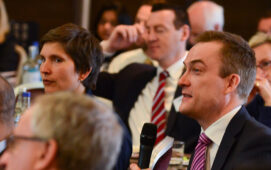By Zoe Schiff
If you thought MiFID II was a topic confined to the harried people of the EU, think again. Concerned New Yorkers packed a breakfast briefing earlier this month to hear how the far-reaching regulation will impact the European trading landscape – and open opportunities for US traders to broaden their horizons. They also enjoyed a Michelin Starred breakfast courtesy of the event’s hosts: USAM Group, Interxion, and Quincy Data.
Discussion centred on a white paper presented by co-author Andrew Delaney, president and chief content officer at A-Team Group, who was joined by Laurent Partouche, VP of Business Development and Buy Side Relationship Management at Eurex, and Stéphane Ty?, Co-founder of McKay Brothers.
MiFID II was a common theme from the start, with the A-Team paper analyzing how the regulation will affect infrastructure considerations for those looking to trade on the EU’s main execution venues: the London Stock Exchange, Eurex, Deutsche Boerse, ICE Futures Europe, Nasdaq Europe, BATS Chi-X.
A major conclusion was the importance of selecting the appropriate entry point, the data centre at which firms place their execution servers for optimal access to the venues and supporting services they need to trade according to their strategies and ensure MiFID II-compliance. Interxion’s Bill Fenick briefly made the case for the company’s City of London data centre, which sits between the important Slough (BATS Chi-X) and Basildon (ICE Futures Europe) data centres, close to the LSE’s own City data centre, and is connected by microwave via the ‘Frankfurt Corridor’ to the all-important Eurex and DB Xetra markets.
More broadly, the speakers agreed that MiFID II will level the playing field and boost transparency, creating a trading environment akin to that in the US. But it would also introduce a host of new complications for US firms trading in Europe.
“MiFID II presents challenges, but it also presents opportunities,” Delaney said. “The net effect of the new regulation will be a more transparent, consistent, and reliable market structure across asset classes, creating a European trading landscape that strongly resembles that in the US and boosting its appeal to US investment firms.”
Partouche presented numerous strategies for overcoming some of these new challenges – arbitrage was a key component of the Eurex trader’s suggested maneouvres.
“MiFID II will be implemented in 2017 to increase market transparency and will impact direct market access, the German HFT law, market makers, and reporting. The German HFT law entered into force on May 15, 2013. The HFTs have to be properly licensed, the Order to Trade Ratios are monitored, an Excessive System Usage (ESU) fee can apply, and trading algorithms have to be flagged,” said Partouche.
The potential of microwave networks in latency reduction was another key component of the discussion. Microwave networks can offer a 40% improvement in latency over fibre connections. Ty? emphasized the intensity of competition within his field and the progress being made.
“The next big things are building over water, increasing the bandwidth, more destinations, and more shared services. Microwave networks are here to stay—there is a fierce and healthy competition,” said stated Ty?.
Stay tuned for more events—you may have missed a Michelin-starred breakfast, but who knows what’s next on the horizon! To read more about the event or to view the presentations, click here.
Subscribe to our newsletter




